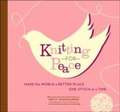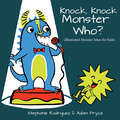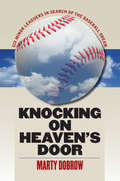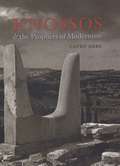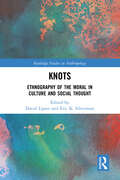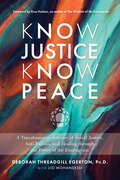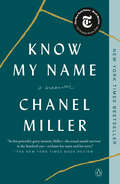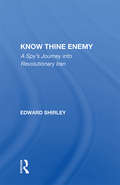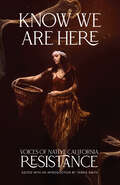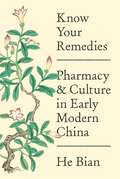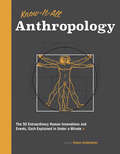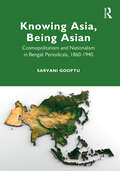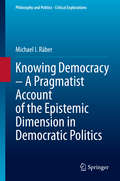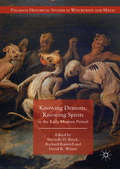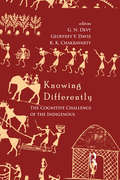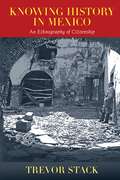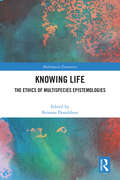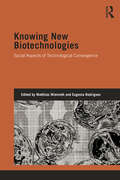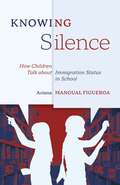- Table View
- List View
Knitting for Good!: A Guide to Creating Personal, Social, and Political Change Stitch by Stitch
by Betsy GreerEvery time we knit, we have the opportunity to create positive change in ourselves, our community, and in the world. That's Betsy Greer's fervent belief, and in this book she shows us how. Betsy explores the ways we can use knitting to slow down in a fast-paced culture, while using the craft to benefit charities in our communities, to advocate for worthwhile causes, and to support individuals and communities across the globe. Filled with insights from knitters and crafters on how they use craft to benefit others, Knitting for Good! will get you thinking about knitting in a whole new way. To learn more about the author, visit her website: craftivism.com
Knitting for Peace: Make the World a Better Place One Stitch at a Time
by Betty ChristiansenAll across America, people are knitting for peace. In yarn shops and private homes, churches and synagogues, schools and even prisons, they meet on weekday evenings or weekend afternoons to knit afghans for refugees, mittens for the homeless, socks for soldiers, or preemie caps for AIDS babies. The tradition goes back as far as Martha Washington, who spearheaded knitting efforts for the soldiers of the Revolutionary War, and has seen a recent flourishing in what is nowadays called "charity knitting," "community knitting," or "knitting for others. " And whether it's for world peace, community peace, or peace of mind, today's various causes have the common goal of knitting the world into a better place one stitch at a time. "Knitting for Peace" is an exceptional book that celebrates the long heritage of knitting for others. It tells the stories of 28 contemporary knitting-for-peace endeavors, and features patterns for easy-to-knit charity projects such as hats, socks, blankets, and bears, plus a messenger bag emblazoned with the "Knitting for Peace" logo. Enlivened by anecdotal sidebars and quotations from both knitters and peacemakers, this inspiring book also includes everything readers need to know to start their own knitting-for-peace groups. Picture descriptions present.
Knock, Knock, Monster Who?: Illustrated Monster Jokes for Kids (Illustrated Jokes)
by Stephanie Rodriguez Amy PryceMonsters growl and snarl and groan and these silly illustrated jokes! Get kids reading AND laughing with funny monster jokes. Adam Pryce's bold illustrations add to the hilarity of monsters doing all sorts for ridiculous things. Developing readers will build confidence and story time will never be the same for your monster-loving child. Here's an example: What do sea monsters have for dinner? Fish and ships! These jokes are silly and strange and make a great gift for a monster fan. Don't miss the other illustrated joke books in this series including: Yo Ho, Ha Ha! Pirate Jokes for kids Knock Knock, Moo Who? It's Snot Fair! Knock Knock, Dino-mite! and many more from Xist Publishing!
Knock, Knock: In Pursuit of a Grand Unified Theory of Humour
by William HartstonThe first mainstream history of humour. Hilarious and well-researched, this book from household name William Hartston, a presenter, author and journalist, makes a perfect gift.Of all human qualities, humour is perhaps the most puzzling. In this very first history of humour, author and humourist William Hartston looks at every aspect of the evolution of humour and our attitudes towards it with a view to developing a proper Theory Of Everything Humorous.From comedy in ancient Greece and jokes in ancient Rome, to laughter in the Bible and the secret of comic delivery; from how humour changed following the American civil war, to how Mark Twain changed written comedy in the English-speaking world, William leaves no stone unturned in his quest to understand what makes us chuckle. Besides being academically well-founded, A History of Humour will, unlike almost everything else written on the subject, be both seriously humorous and humorously serious.
Knocking on Heaven’s Door: Six Minor Leaguers in Search of the Baseball Dream
by Marty DobrowThe rich slice of Americana found in minor league baseball presents a contradictory culture. On the one hand, the minors are filled with wholesome, family-friendly entertainment-fluffy mascots, kitschy promotions, and earnest young men signing autographs for wide-eyed Little Leaguers. On the other, they comprise a world of cutthroat competition in which a teammate's failure or injury can be the cause of quiet celebration and 90 percent of all players never play a single inning in the major leagues. In Knocking on Heaven's Door, award-winning sportswriter Marty Dobrow examines this double-edged culture by chronicling the lives of six minor leaguers-Brad Baker, Doug Clark, Manny Delcarmen, Randy Ruiz, Matt Torra, and Charlie Zink-all struggling to make their way to "The Show." What links them together, aside from their common goal, is that they are all represented by the same team of agents-Jim and Lisa Masteralexis and their partner Steve McKelvey-whose own aspirations parallel those of the players they represent. The story begins during spring training in 2005 and ends in the fall of 2008, followed by a brief epilogue that updates each player's fortunes through the 2009 season. Along the way Dobrow offers a revealing, intimate look at life in minor league baseball: the relentless tedium of its itinerant routines and daily rituals; the lure of performance-enhancing drugs as a means of gaining a competitive edge; the role of agents in negotiating each player's failures as well as his successes; and the influence of wives, girlfriends, and family members who have invested in the dream.
Knockout: The Boxer and Boxing in American Cinema
by Leger GrindonKnockout: The Boxer and Boxing in American Cinema is the first book-length study of the Hollywood boxing film, a popular movie entertainment since the 1930s, that includes such classics as Million Dollar Baby, Rocky, and Raging Bull. The boxer stands alongside the cowboy, the gangster, and the detective as a character that shaped America’s ideas of manhood. Leger Grindon relates the Hollywood boxing film to the literature of Jack London, Ernest Hemingway, and Clifford Odets; the influence of ring champions, particularly Joe Louis and Muhammad Ali; and controversies surrounding masculinity, race, and sports. Knockout breaks new ground in film genre study by focusing on the fundamental dramatic conflicts uniting both documentary and fictional films with compelling social concerns. The boxing film portrays more than the rise and fall of a champion; it exposes the body to reveal the spirit. Not simply a brute, the screen boxer dramatizes conflicts and aspirations central to an American audience’s experience. This book features chapters on the conventions of the boxing film, the history of the genre and its relationship to famous ring champions, and self-contained treatments of thirty-two individual films including a chapter devoted to Raging Bull.
Knossos and the Prophets of Modernism
by Cathy GereIn the spring of 1900, British archaeologist Arthur Evans began to excavate the palace of Knossos on Crete, bringing ancient Greek legends to life just as a new century dawned amid far-reaching questions about human history, art, and culture. Over the next three decades, Evans engaged in an unprecedented reconstruction project, creating a complex of concrete buildings on the site that owed at least as much to modernist architecture as they did to Bronze Age remains. In the process, he fired the imaginations of a whole generation of intellectuals and artists, whose work would drive movements as disparate as fascism and pacifism, feminism and psychoanalysis. With Knossos and the Prophets of Modernism, Cathy Gere relates the fascinating story of Evans's excavation and its long-term effects on Western culture. Gere shows how Evans's often-fanciful account of ancient Minoan society captivated a generation riven by serious doubts about the fundamental values of European civilization. After the First World War left the Enlightenment dream in tatters, the lost paradise that Evans offered in the concrete labyrinth--pacifist and matriarchal, pagan and cosmic--seemed to offer a new way forward for writers, artists, and thinkers such as Freud, James Joyce, Georgio de Chirico, Robert Graves, Hilda Doolittle, all of whom emerge as forceful characters in Gere's account. Assembling a brilliant, talented, and eccentric cast at a moment of tremendous intellectual vitality and wrenching change, Cathy Gere paints an unforgettable portrait of the age of concrete and the birth of modernism.
Knot of the Soul: Madness, Psychoanalysis, Islam
by Stefania PandolfoThrough a dual engagement with the unconscious in psychoanalysis and Islamic theological-medical reasoning, Stefania Pandolfo’s unsettling and innovative book reflects on the maladies of the soul at a time of tremendous global upheaval. Drawing on in-depth historical research and testimonies of contemporary patients and therapists in Morocco, Knot of the Soul offers both an ethnographic journey through madness and contemporary formations of despair and a philosophical and theological exploration of the vicissitudes of the soul. Knot of the Soul moves from the experience of psychosis in psychiatric hospitals, to the visionary torments of the soul in poor urban neighborhoods, to the melancholy and religious imaginary of undocumented migration, culminating in the liturgical stage of the Qur’anic cure. Demonstrating how contemporary Islamic cures for madness address some of the core preoccupations of the psychoanalytic approach, she reveals how a religious and ethical relation to the “ordeal” of madness might actually allow for spiritual transformation. This sophisticated and evocative work illuminates new dimensions of psychoanalysis and the ethical imagination while also sensitively examining the collective psychic strife that so many communities endure today.
Knots: Ethnography of the Moral in Culture and Social Thought (Routledge Studies in Anthropology)
by David Lipset Eric K. SilvermanKnots are well known as symbols of moral relationships. This book develops an exciting new view of this otherwise taken-for-granted image and considers their metaphoric value in and for moral order. In chapters that focus on Japan, China, Europe, South America and in several Pacific Island societies, granular ethnography depicts how knots are deployed to express unity in daily and ritual embodiment, political authority and the cosmos, as well as in social thought. The volume will be of interest to anthropologists and other scholars concerned with metaphor and symbolism, material culture and technology.
Know Justice Know Peace: A Transformative Journey of Social Justice, Anti-Racism, and Healing through the Power of the Enneagram
by Deborah Threadgill EgertonA first-of-its-kind guide to social justice through the lens of the Enneagram--a popular personality typing system--that shows how people can use their particular type to work on issues such as antiracism and homophobia.Know Justice Know Peace is a unique guide told through the lens of the Enneagram that provides readers with a pathway to activating their authentic self so that they may participate in the healing all of humanity. Dr. Egerton will help the reader discover the indisputable fact of how deeply and intricately we are all connected.The reader is invited to explore their own personality archetype and to activate themselves as allies within a beloved community; a community that acknowledges that, while we come in many shades and colors, we are part of one human race. This book will serve all Enneagram practitioners regardless of race, religion, gender, or any "othering" category.Readers will explore: the cultural challenges of the social construct of race and the intersection of inner work through the nine different lenses of the Enneagram.their own meaning of "other" and allow it to surface in their consciousness, perhaps for the first timethe full concept of "other" and their early experience with differencestheir individual journey and the possibility of healing their own wounds and finding positive outcomes to help heal the worldKnow Justice Know Peace brilliantly illuminates how the inner work of each of the 9 Enneagram archetypes creates healing, elevates the consciousness, and aligns us as individuals with the heart of humanity in order to eliminate systemic racism. It provides the reader with a guide to activating their authentic self so that they may participate in the healing all of humanity.
Know My Name: A Memoir
by Chanel Miller<P><P>The riveting, powerful memoir of the woman whose statement to Brock Turner gave voice to millions of survivors <P><P>She was known to the world as Emily Doe when she stunned millions with a letter. Brock Turner had been sentenced to just six months in county jail after he was found sexually assaulting her on Stanford's campus. <P><P>Her victim impact statement was posted on BuzzFeed, where it instantly went viral--viewed by eleven million people within four days, it was translated globally and read on the floor of Congress; it inspired changes in California law and the recall of the judge in the case. Thousands wrote to say that she had given them the courage to share their own experiences of assault for the first time. <P><P>Now she reclaims her identity to tell her story of trauma, transcendence, and the power of words. It was the perfect case, in many ways--there were eyewitnesses, Turner ran away, physical evidence was immediately secured. But her struggles with isolation and shame during the aftermath and the trial reveal the oppression victims face in even the best-case scenarios. <P><P>Her story illuminates a culture biased to protect perpetrators, indicts a criminal justice system designed to fail the most vulnerable, and, ultimately, shines with the courage required to move through suffering and live a full and beautiful life. <P><P>Know My Name will forever transform the way we think about sexual assault, challenging our beliefs about what is acceptable and speaking truth to the tumultuous reality of healing. It also introduces readers to an extraordinary writer, one whose words have already changed our world. Entwining pain, resilience, and humor, this memoir will stand as a modern classic. <P><P><b>A New York Times Bestseller</b>
Know Thine Enemy: A Spy's Journey Into Revolutionary Iran
by Edward ShirleyThis book gives an account of Shirley's trip into Iran as a spy to provide an insight into Iranian character. It is a vivid, firsthand portrait of the clash of Western and Muslim civilizations. The book portrays Iranians in a way different from what the most Americans know about them.
Know We Are Here: Voices of Native California Resistance
by Terria SmithAn essential look at the ways California’s Native nations are resisting colonialism today, from education reform to protests against environmental injustice and beyond.Collecting over twenty-five essays written by more than twenty California Indian authors, Know We Are Here surveys many of the ways California’s Indigenous communities are resisting the legacies of genocide. Focusing on the particular histories, challenges, and dynamics of life in Native California—which are often very different from elsewhere in the United States—the book collects essays from writers across the state. It encompasses the perspectives of both elders and the rising generation, and the contributors include activists, academics, students, memoirists, and tribal leaders. The collection examines histories of resistance to colonialism in California, the reclaiming of cultures and languages, the connection of place and nature to wellness in tribal communities, efforts to overhaul the racist presentation of California Indians in classrooms and popular culture, and the meanings of solidarity in Native California. Unifying the book is an introduction by Terria Smith (Torres Martinez Desert Cahuilla Indians), editor of the renowned and long-running magazine News from Native California. This book is an indispensable resource for California Indian readers, educators of all levels in California, and students in Native studies courses nationally.
Know Your Remedies: Pharmacy and Culture in Early Modern China
by He BianA cultural history of the concept of pharmacy, both the material nature of drugs and the trade in medicine, in early modern China Know Your Remedies presents a panoramic inquiry into China’s early modern cultural transformation through the lens of pharmacy. In the history of science and civilization in China, pharmacy—as a commercial enterprise and as a branch of classical medicine—resists easy characterization. While China’s long tradition of documenting the natural world through state-commissioned pharmacopeias, known as bencao, dwindled after the sixteenth century, the ubiquitous presence of Chinese pharmacy shops around the world today testifies to the vitality of Traditional Chinese Medicine. Rejecting narratives of intellectual stagnation or an unchanging folk culture, He Bian argues that pharmacy’s history in early modern China can best be understood as a dynamic interplay between elite and popular culture.Beginning with decentralizing trends in book culture and fiscal policy in the sixteenth century, Bian reveals pharmacy’s central role in late Ming public discourse. Fueled by factional politics in the early 1600s, amateur investigation into pharmacology reached peak popularity among the literati on the eve of the Qing conquest in the mid-seventeenth century. The eighteenth century witnessed a systematic reclassification of knowledge, as the Qing court turned away from pharmacopeia in favor of a demedicalized natural history. Throughout this time, growth in long-distance trade enabled the rise of urban pharmacy shops, generating new knowledge about the natural world.Bringing together a wealth of primary sources, Know Your Remedies makes an essential contribution to the study of Chinese history and the history of medicine.
Know-It-All Anthropology: The 50 Extraordinary Human Innovations and Events, Each Explained in Under a Minute (Know It All Ser. #9)
by Simon UnderdownAn informative reference containing concise explanations for the major anthropological discoveries in human physical, cultural, and social history.Who are we? What is it about our species that sets us apart from every other living creature, past and present, on this planet?These are perennially compelling questions about human evolution and development that continue to cudgel the best brains on earth. Know-It-All Anthropology seeks to understand the roots of our common humanity, the diversity of cultures and world-views, and the organization of social relations and practices.If you only have under a minute, that is enough time—by reading this book—to meet the ancestors and master the basic ideas, personalities, controversies, and future directions of the study of humankind.The Know It All takes a revolutionary approach to learning about the subjects you really feel you should understand but have never gotten around to studying. Each book selects a popular topic and dissects it into the fifty most significant ideas at its heart. Each idea, no matter how complex, is explained in three hundred words and one picture, all digestible in under a minute.Other titles in this series include: Know It All Chemistry, Know It All Classical Music, Know It All Energy, Know It All Fashion, Know It All Great Inventions, Know It All Jazz, Know It All Medicine, Know It All Shakespeare, Know It All Whiskey, Know It All Wine, Space In 30 Seconds, Sports in 30 Seconds.
Knowing Asia, Being Asian: Cosmopolitanism and Nationalism in Bengali Periodicals, 1860–1940
by Sarvani GooptuThis book studies the various representations of Asia in Bengali literary periodicals between the 1860s and 1940s. It looks at how these periodicals tried to analyse the political situation in Asia in the context of world politics and how Indian nationalistic ideas and associations impacted their vision. The volume highlights the influences of cosmopolitanism, universalism and nationalism which contributed towards a common vision of a united and powerful Asia and how these ideas were put into practice. It analyses travel accounts by men and women and examines how women became the focus of the didactic efforts of all writers for a horizontal dissemination of Asian consciousness. The author also provides a discussion on Asian art and culture, past and present connections between Asian countries and the resurgence of 19th-century Buddhism in the consciousness of the Bengalis. Rich in archival material, Knowing Asia, Being Asian will be useful for scholars and researchers of history, Asian studies, modern India, cultural studies, media studies, journalism, publishing, post-colonial studies, travel writings, women and gender studies, political studies and social anthropology.
Knowing Democracy – A Pragmatist Account of the Epistemic Dimension in Democratic Politics (Philosophy and Politics - Critical Explorations #14)
by Michael I. RäberHow can we justify democracy’s trust in the political judgments of ordinary people? In Knowing Democracy, Michael Räber situates this question between two dominant alternative paradigms of thinking about the reflective qualities of democratic life: on the one hand, recent epistemic theories of democracy, which are based on the assumption that political participation promotes truth, and, on the other hand, theories of political judgment that are indebted to Hannah Arendt’s aesthetic conception of political judgment. By foregrounding the concept of political judgment in democracies, the book shows that a democratic theory of political judgments based on John Dewey’s pragmatism can navigate the shortcomings of both these paradigms. While epistemic theories are overly and narrowly rationalistic and Arendtian theories are overly aesthetic, the neo-Deweyan conception of political judgment proposed in this book suggests a third path that combines the rationalist and the aesthetic elements of political conduct in a way that goes beyond a merely epistemic or a merely aesthetic conception of political judgment in democracy. The justification for democracy’s trust in ordinary people’s political judgments, Räber argues, resides in an egalitarian conception of democratic inquiry that blends the epistemic and the aesthetic aspects of the making of political judgments. By offering a rigorous scholarly analysis of the epistemic and aesthetic foundations of democracy from a pragmatist perspective, Knowing Democracy contributes to the current debates in political epistemology and aesthetics and politics, both of which ask about the appropriate reflective and experiential circumstances of democratic politics. The book brings together for the first time debates on epistemic democracy, aesthetic judgment and those on pragmatist social epistemology, and establishes an original pragmatist conception of epistemic democracy.
Knowing Demons, Knowing Spirits in the Early Modern Period (Palgrave Historical Studies in Witchcraft and Magic)
by Michelle D. Brock Richard Raiswell David R. WinterThis book explores the manifold ways of knowing—and knowing about— preternatural beings such as demons, angels, fairies, and other spirits that inhabited and were believed to act in early modern European worlds. Its contributors examine how people across the social spectrum assayed the various types of spiritual entities that they believed dwelled invisibly but meaningfully in the spaces just beyond (and occasionally within) the limits of human perception. Collectively, the volume demonstrates that an awareness and understanding of the nature and capabilities of spirits—whether benevolent or malevolent—was fundamental to the knowledge-making practices that characterize the years between ca. 1500 and 1750. This is, therefore, a book about how epistemological and experiential knowledge of spirits persisted and evolved in concert with the wider intellectual changes of the early modern period, such as the Protestant Reformation, the Scientific Revolution, and the Enlightenment.
Knowing Differently: The Challenge of the Indigenous
by G. N. Devy Geoffrey V. Davis K. K. ChakravartyThis book offers a bold and illuminating account of the worldviews nurtured and sustained by indigenous communities from across continents, through their distinctive understanding of concepts such as space, time, joy, pain, life, and death. It demonstrates how this different mode of ‘knowing’ has brought the indigenous into a cultural conflict with communities that claim to be modern and scientific. Bringing together scholars, artists and activists engaged in understanding and conserving local knowledge that continues to be in the shadow of cultural extinction, the book attempts to interpret repercussions on identity and cultural transformation and points to the tragic fate of knowing the world differently. The volume inaugurates a new thematic area in post-colonial studies and cultural anthropology by highlighting the perspectives of marginalized indigenous communities, often burdened with being viewed as ‘primitive’. It will be useful to scholars and students of anthropology, sociology, cultural studies, history, linguistics, literature, and tribal studies.
Knowing History in Mexico: An Ethnography of Citizenship
by Trevor StackWhile much has been written about national history and citizenship, anthropologist Trevor Stack focuses on the history and citizenship of towns and cities. Basing his inquiry on fieldwork in west Mexican towns near Guadalajara, Stack begins by observing that people talked (and wrote) of their towns&’ history and not just of Mexico&’s.Key to Stack&’s study is the insight that knowing history can give someone public status or authority. It can make someone stand out as a good or eminent citizen. What is it about history that makes this so? What is involved in knowing history and who is good at it? And what do they gain from being eminent citizens, whether of towns or nations?As well as academic historians, Stack interviewed people from all walks of life—bricklayers, priests, teachers, politicians, peasant farmers, lawyers, and migrants. Resisting the idea that history is intrinsically interesting or valuable—that one simply must know the past in order to understand the present—he explores the very idea of &“the past&” and asks why it is valued by so many people.
Knowing Life: The Ethics of Multispecies Epistemologies (Multispecies Encounters)
by Donaldson, Edited by BrianneKnowing Life examines the limits of dominant knowledge forms that contribute to current practices negatively affecting more-than-human beings, while also exploring alternative approaches to knowing that are capable of reducing harm and maximizing planetary thriving.Specifically, this volume seeks multispecies answers to long-standing questions in Western philosophy: Who or what counts as a knower? What kinds of knowing are valid? Is knowledge a product of mind, body, or something else? Historically, these epistemic questions have been answered in ways that neutralize the knowing and knowledge contribution of and for more-than-human beings, as well as those on the margins of society considered less than “human.” Consequently, these epistemic assumptions often support the destruction of ecological habitats, industrialization of food animals, widespread use of insect and plant toxins, water and air pollution, climate extinctions, ecological militarism, and the perpetual flow of living beings used for entertainment, research, clothing, companionship, and economic resources.In this book, crosscultural and multidisciplinary contributors—including lesser-known global religious-philosophical accounts, philosophies of plant and insect life, race and disability studies, laboratory epistemology, embodied semiotics, and scholar-artists—challenge and expand these classical concepts through diverse modes of embodied engagement on multispecies knowing toward open futures of planetary co-flourishing.
Knowing Native Arts
by Nancy Marie MithloKnowing Native Arts brings Nancy Marie Mithlo&’s Native insider perspective to understanding the significance of Indigenous arts in national and global milieus. These musings, written from the perspective of a senior academic and curator traversing a dynamic and at turns fraught era of Native self-determination, are a critical appraisal of a system that is often broken for Native peoples seeking equity in the arts. Mithlo addresses crucial issues, such as the professionalization of Native arts scholarship, disparities in philanthropy and training, ethnic fraud, and the receptive scope of Native arts in new global and digital realms. This contribution to the field of fine arts broadens the scope of discussions and offers insights that are often excluded from contemporary appraisals.
Knowing New Biotechnologies: Social Aspects of Technological Convergence (Genetics and Society)
by Matthias Wienroth Eugénia RodriguesThe areas of personal genomics and citizen science draw on – and bring together – different cultures of producing and managing knowledge and meaning. They also cross local and global boundaries, are subjects and objects of transformation and mobility of research practices, evaluation and multi-stakeholder groups. Thirdly, they draw on logics of ‘convergence’: new links between, and new kinds of, stakeholders, spaces, knowledge, practices, challenges and opportunities. This themed collection of essays from nationally and internationally leading scholars and commentators advances and widens current debates in Science and Technology Studies and in Science Policy concerning ‘converging technologies’ by complementing the customary focus on technical aspirations for convergence with the analysis of the practices and logics of scientific, social and cultural knowledge production that constitute contemporary technoscience. In case studies from across the globe, contributors discuss the ways in which science and social order are linked in areas such as direct-to consumer genetic testing and do-it-yourself biotechnologies. Organised into thematic sections, ‘Knowing New Biotechnologies’ explores: • ways of understanding the dynamics and logics of convergences in emergent biotechnologies • governance and regulatory issues around technoscientific convergences • democratic aspects of converging technologies – lay involvement in scientific research and the co-production of biotechnology and social and cultural knowledge.
Knowing Otherwise: Race, Gender, and Implicit Understanding (G - Reference, Information and Interdisciplinary Subjects)
by Alexis ShotwellPrejudice is often not a conscious attitude: because of ingrained habits in relating to the world, one may act in prejudiced ways toward others without explicitly understanding the meaning of one’s actions. Similarly, one may know how to do certain things, like ride a bicycle, without being able to articulate in words what that knowledge is. These are examples of what Alexis Shotwell discusses in Knowing Otherwise as phenomena of “implicit understanding.” Presenting a systematic analysis of this concept, she highlights how this kind of understanding may be used to ground positive political and social change, such as combating racism in its less overt and more deep-rooted forms. Shotwell begins by distinguishing four basic types of implicit understanding: nonpropositional, skill-based, or practical knowledge; embodied knowledge; potentially propositional knowledge; and affective knowledge. She then develops the notion of a racialized and gendered “common sense,” drawing on Gramsci and critical race theorists, and clarifies the idea of embodied knowledge by showing how it operates in the realm of aesthetics. She also examines the role that both negative affects, like shame, and positive affects, like sympathy, can play in moving us away from racism and toward political solidarity and social justice. Finally, Shotwell looks at the politicized experience of one’s body in feminist and transgender theories of liberation in order to elucidate the role of situated sensuous knowledge in bringing about social change and political transformation.
Knowing Silence: How Children Talk about Immigration Status in School
by Ariana Mangual FigueroaLearning from children about citizenship status and how it shapes their schooling There is a persistent assumption in the field of education that children are largely unaware of their immigration status and its implications. In Knowing Silence, Ariana Mangual Figueroa challenges this &“myth of ignorance.&” By listening carefully to both the speech and significant silences of six Latina students from mixed-immigration-status families, from elementary school into middle school and beyond, she reveals the complex ways young people understand and negotiate immigration status and its impact on their lives. Providing these children with iPod Touches to record their own conversations, Mangual Figueroa observes when and how they choose to talk about citizenship at home, at school, and in public spaces. Analyzing family conversations about school forms, in-class writing assignments, encounters with the police, and applications for college, she demonstrates that children grapple with the realities of citizenship from an early age. Educators who underestimate children&’s knowledge, Mangual Figueroa shows, can marginalize or misunderstand these students and their families. Combining significant empirical findings with reflections on the ethical questions surrounding research and responsibility, Mangual Figueroa models new ways scholars might collaborate with educators, children, and families. With rigorous and innovative ethnographic methodologies, Knowing Silence makes audible the experiences of immigrant-origin students in their own terms, ultimately offering teachers and researchers a crucial framework for understanding citizenship in the contemporary classroom.

